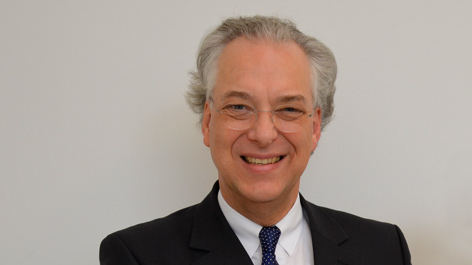Michael Eissenhauer: “Comprehending the World in its Entirety “
News from 11/21/2017
On 25 November 2017 admission is free on the Museumsinsel and at the Kulturforum for the Activities Day “On the Way to the Humboldt Forum“. We spoke with Michael Eissenhauer, Director-General of the Staatliche Museen, about the upcoming convergence of cultures on show for free on 25 November as a foretaste of the Humboldt Forum.

Mr Eissenhauer, the Activities Day on 25 November is taking place under the motto “On the Way to the Humboldt Forum“. Is the journey itself also partly the goal for the Staatliche Museen?
First of all, our goal to develop a comprehensive presentation of the collections of the Ethnologisches Museum and the Museum für Asiatische Kunst in the heart of Berlin naturally remains unchanged. This new spatial configuration will open up completely new possibilities and approaches, which we anticipate with great pleasure. At the same time we want to show that what we plan to achieve in the future Humboldt Forum doesn’t just start in 2019, but is something we are already putting into practice now. Interdisciplinary exhibitions that transcend the boundaries between collections are already a matter of course for an encyclopaedic or “universal“ museum like the Staatliche Museen zu Berlin, as recent examples like “Alchemy“ at the Kulturforum or “Beards“ at the Neues Museum have shown. The necessity of closing the non-European Museums in Dahlem for relocation now offers us the opportunity to expand that interdisciplinary work to include these two collections, and to intensify our approach to the journey to the Humboldt Forum as a field for experimentation.
The royal Kunstkammer, which in Berlin dated all the way back to the 16th century and formed the core of the collections that now belong to the Staatliche Museen, is one source of inspiration for the Humboldt Forum. Could you briefly explain this analogy?
Even back then no distinction was made between high culture and everyday culture. Objects from all over the world that were considered fascinating, beautiful, and charming were gathered together, with the goal of understanding the world in its entirety. This is the idea that we want to revive in the Humboldt Forum, where world cultures will be brought together with the historical cultures of Europe. The exhibition “Art from Africa in the Bode-Museum“ provides a foretaste of this, as do other exhibitions like “New Neighbours“ or “Vis à Vis: Asia meets Europe“, which showcase the collections of the Ethnologisches Museum and the Museum für Asiatische Kunst on the Museumsinsel and at the Kulturforum.
What happens in these cultural encounters? What do visitors see, for example, in the exhibition “Art from Africa in the Bode-Museum“?
Even in very different cultures, artists have reached comparable solutions in their quest for beauty, representation, or function. For example, the exhibition presents a juxtaposition of protective figures: a Virgin of Mercy from the late 15th century encounters a 19th-century “power figure“ from the Congo. Almost no formal similarities exist between the two. What the figures share, however, is the fundamental idea behind their creation, namely the belief that a revered sculpture can take on a protective role based on its particular form and composition. In both Europe and Africa such sculptures were associated with feelings of comfort, security, and safety for a long time. Such similarities in content or form, as well as the differences, are revealed in many examples in the exhibition.
What else makes the exhibition so appealing from an organizer’s point of view?
The actual appeal of the exhibition arises from the interdisciplinary cooperation. The art-historical point of view and the ethnological point of view converge. Each discipline has different methods and approaches. Ethnologists for example first investigate an object’s function and integration into daily life. Art historians, by contrast, are interested in stylistic history, iconography, and composition. These approaches not only differ, they are to some extent foreign to each other. These differences, however, can expand our horizons. The exhibition represents a collegial embrace of one discipline with another.
You are not only Director-General of the Staatliche Museen zu Berlin, but also Director of the Gemäldegalerie. With “Faces of China“ at the Kulturforum a European museum now presents the first comprehensive exhibition explicitly dedicated to Chinese portrait painting. What inspires you about this exhibition?
The unbelievable abundance and wide spectrum of portraits from five centuries that we can present here. While portraiture is a, if not the dominant category of painting in the Gemäldegalerie, as it is in most Old Master collections, when we look at Chinese paintings in European collections we generally find that landscapes, flowers, and birds predominate. This is partly a result of the history of collecting in Europe, and of our viewing habits. An exhibition that comprehensively addresses the various traditions of Chinese portraiture thus sets a completely new tone. This exhibition also would never have been possible in Berlin without generous and spectacular loans, most of which have never been shown in Europe, above all from the Palace Museum in Beijing and the Royal Ontario Museum in Toronto. The opportunity to present these masterpieces next door to “my“ Old Masters naturally gives me particular pleasure. We also display selected works like Anthony van Dyck’s Genoese Lady and the portrait of Yang Woxing from the same period in direct comparison.
Interview by Gesine Bahr-Reisinger.
Links for Additional Information
- Informationen on the Activities Day “On the Way to the Humboldt Forum“
- Exhibition: China and Egypt. Cradles of the World, Neues Museum
- Exhibition: Beyond Compare: Art from Africa in the Bode-Museum
- Exhibition: Faces of China. Portrait Painting of the Ming and Qing Dynasties (1368–1912), Kulturforum
- Exhibition: Vis à Vis: Asia Meets Europe, Kunstgewerbemuseum
- Exhibition: Exchanging Gazes. Between China and Europe 1669–1907, Kunstbibliothek
- Dossier Humboldt Forum

